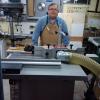Dominoes are
loose tenons or floating tenons, not dovetails, or anything else. Inventors of the dj never intended a dj to do dowel holes...a dj is not a hole drilling machine.
Mortises of varying sizes, yes, by changing the fence heights and, as I said earlier, overlapping the cuts (in which case, non-Festool dominoes/tenons need to be made. It is faster and more accurate to use double, triple, twin or twin double etc. dominoes, however.
Compound angle mortises? Do you have a link to what they are? As long as a joint can be completed using the traditional M&T or the floating tenons, any angles are doable.
http://4dfurniture.blogspot.com/2016/05/
The dj is an under-appreciated machine when people relate to it as a biscuit joiner or doweling jig. It has a deep learning curve, and other users disagree on that statement because they are thinking about the learning curve for the basic functions of a dj only: butt joint, jointing, miters, etc., tasks that can be done equally well with biscuits, pocket hole joinery, or even just plain glue. For instance, we see a lot of pictures showing the dominoes in edge jointing...for
many of which dominoes were totally unnecessary, or an extra step with no extra benefits. I seldom use dominoes for jointing unless it is something 1" thick and 3" or 4' long or more.
Simon





 Reply With Quote
Reply With Quote





